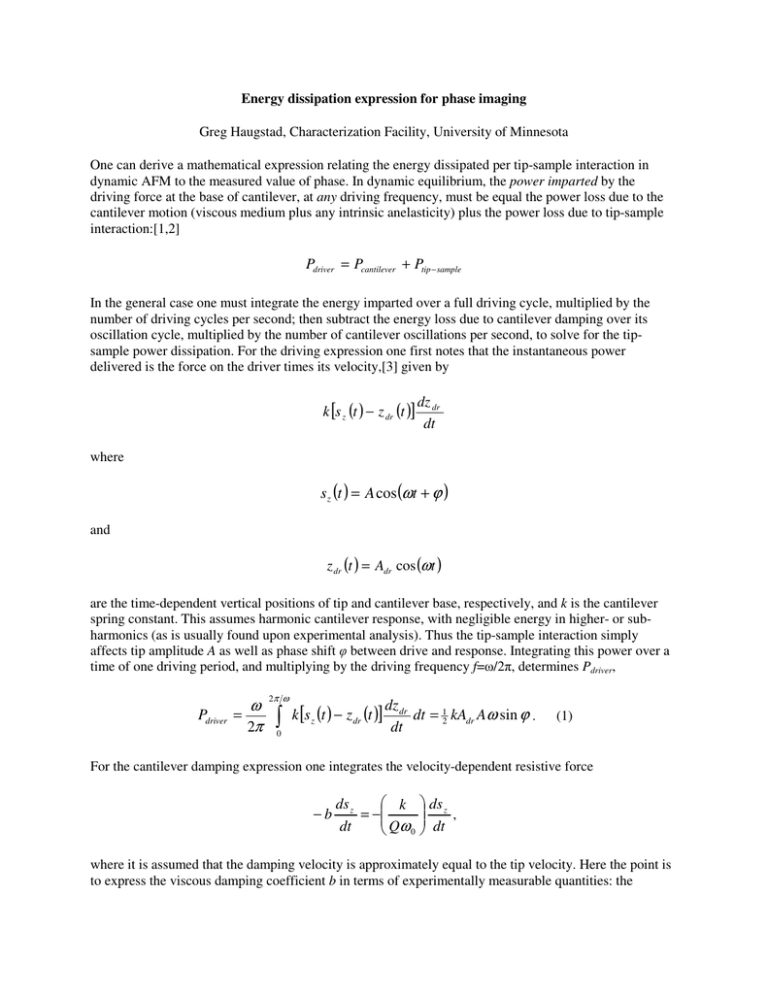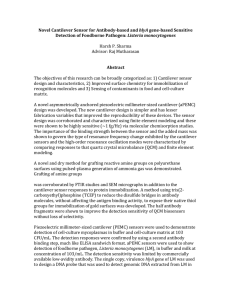Energy dissipation expression - U of MN
advertisement

Energy dissipation expression for phase imaging Greg Haugstad, Characterization Facility, University of Minnesota One can derive a mathematical expression relating the energy dissipated per tip-sample interaction in dynamic AFM to the measured value of phase. In dynamic equilibrium, the power imparted by the driving force at the base of cantilever, at any driving frequency, must be equal the power loss due to the cantilever motion (viscous medium plus any intrinsic anelasticity) plus the power loss due to tip-sample interaction:[1,2] Pdriver = Pcantilever + Ptip − sample In the general case one must integrate the energy imparted over a full driving cycle, multiplied by the number of driving cycles per second; then subtract the energy loss due to cantilever damping over its oscillation cycle, multiplied by the number of cantilever oscillations per second, to solve for the tipsample power dissipation. For the driving expression one first notes that the instantaneous power delivered is the force on the driver times its velocity,[3] given by k [s z (t ) − z dr (t )] dz dr dt where s z (t ) = A cos (ωt + ϕ ) and z dr (t ) = Adr cos (ωt ) are the time-dependent vertical positions of tip and cantilever base, respectively, and k is the cantilever spring constant. This assumes harmonic cantilever response, with negligible energy in higher- or subharmonics (as is usually found upon experimental analysis). Thus the tip-sample interaction simply affects tip amplitude A as well as phase shift φ between drive and response. Integrating this power over a time of one driving period, and multiplying by the driving frequency f=ω/2π, determines Pdriver, Pdriver ω = 2π 2π ω dz ∫ k [s (t ) − z (t )] dt dr z dr dt = 12 kAdr Aω sin ϕ . (1) 0 For the cantilever damping expression one integrates the velocity-dependent resistive force −b k ds z = − dt Qω 0 ds z , dt where it is assumed that the damping velocity is approximately equal to the tip velocity. Here the point is to express the viscous damping coefficient b in terms of experimentally measurable quantities: the cantilever spring constant k, the free resonance frequency ω0 and quality factor Q of the freely oscillating cantilever at a distance just barely beyond tip-sample interaction (see a solution of Newton’s 2nd law of motion for a damped driven harmonic oscillator, e.g., Ref. 4). This does not imply that the effective quality factor of the cantilever under dynamic tip-sample interaction remains that of the free oscillator (certainly not the case), or that the operational drive frequency must be ω0. Integrating this damping over one cycle period determines Pcantilever, Pcantilever ω =− 2π 2π ω ∫ 0 2 k ds z k A 2ω 2 . dt = 12 Qω 0 Qω 0 dt (2) Taking the difference of the expressions for Pdriver (1) and Pcantilever (2) and using the relationship A0 = QAdr yields Ptip − sample = 1 2 kA 2ω Q A0 sin ϕ ω − A ω0 . The energy dissipation per cycle is the power times a time period of 2π/ω, or Etip−sample = πkA2 A0 sin ϕ Q A − ω ω0 Typically ω≈ ω0 to a very good approximation, resulting in the following useful expressions, solving in terms of the energy dissipation per cycle normalized to the total oscillator energy Etip − sample 1 2 kA 2 = 2π Q sin ϕ − 1 , A A0 the right side importantly being independent of cantilever spring constant and dependent on the amplitude reduction A/A0 rather than the magnitude of A or A0; and the phase angle, QEtip − sample A + , A0 πkAA0 ϕ = sin −1 with the inverse sine function providing for two possible values of phase for a given value of energy dissipation (i.e., within each of the attractive and repulsive regimes). [1] J. P. Cleveland et al., “Energy Dissipation in Tapping-Mode Atomic Force Microscopy” Appl. Phys. Lett. 72, 2613 (1998). [2] J. Tamayo and R. Garcia, “Relationship between phase shift and energy dissipation in tapping-mode scanning force microscopy”, Appl. Phys. Lett. 73, 2926 (1998). [3] A. P. French, Vibrations and Waves (Norton, New York, 1971). [4] J.B. Marion, Classical Dynamics of Particles and Systems. 2nd ed. (Academic Press, New York, 1970).



